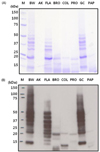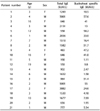1. Ahmed A, Khalid N, Ahmad A, Abbasi NA, Latif MS, Randhawa MA. Phytochemicals and biofunctional properties of buckwheat: a review. J Agric Sci. 2013; FirstView:1–21.

2. Chandrupatla CV, Kundu RV, Aronson IK. Buckwheat allergy and atopic dermatitis. J Am Acad Dermatol. 2005; 53:356–357.

3. Wieslander G, Norbäck D. Buckwheat allergy. Allergy. 2001; 56:703–704.

4. Park KH, Park SM, Lee HH, Kim HY, Jeoung BJ, Kim KE, Lee KY. A clinical study on oral buckwheat provocation test. Pediatr Allergy Respir Dis. 1998; 8:30–36.
5. Takahashi Y, Ichikawa S, Aihara Y, Yokota S. Buckwheat allergy in 90,000 school children in Yokohama. Arerugi. 1998; 47:26–33.
6. Nakamura S, Yamaguchi MY. Studies on the buckwheat allergose report 2: clinical investigation on 169 cases with the buckwheat allergose gathered from the whole country of Japan. Allerg Immunol (Leipz). 1974; 20-21:457–465.
7. Oh JW, Pyun BY, Choung JT, Ahn KM, Kim CH, Song SW, Son JA, Lee SY, Lee SI. Epidemiological change of atopic dermatitis and food allergy in school-aged children in Korea between 1995 and 2000. J Korean Med Sci. 2004; 19:716–723.

8. Sammut D, Dennison P, Venter C, Kurukulaaratchy RJ. Buckwheat allergy: a potential problem in 21st century Britain. BMJ Case Rep. 2011; 2011.

9. Schiffner R, Przybilla B, Burgdorff T, Landthaler M, Stolz W. Anaphylaxis to buckwheat. Allergy. 2001; 56:1020–1021.

10. Heffler E, Nebiolo F, Asero R, Guida G, Badiu I, Pizzimenti S, Marchese C, Amato S, Mistrello G, Canaletti F, Rolla G. Clinical manifestations, co-sensitizations, and immunoblotting profiles of buckwheat-allergic patients. Allergy. 2011; 66:264–270.

11. Nakamura S, Suzuki Y, Ishikawa E, Yakushi T, Jing H, Miyamoto T, Hashizume K. Reduction of in vitro allergenicity of buckwheat Fage 1 through the Maillard-type glycosylation with polysaccharides. Food Chem. 2008; 109:538–545.

12. Morita N, Maeda T, Sai R, Miyake K, Yoshioka H, Urisu A, Adachi T. Studies on distribution of protein and allergen in graded flours prepared from whole buckwheat grains. Food Res Int. 2006; 39:782–790.

13. Lee KY, Lee HH, Kim KE, Park KH, Kim YK, Kong BJ. A comparative study on allergenicity of raw and hypoallergenic buckwheat flour. Pediatr Allergy Respir Dis. 1997; 7:13–22.
14. Yum HY, Ryu JW, Kim KE, Lee KY. Immunoblot analysis of hypoallergenic buckwheat with monoclonal antibodies to raw buckwheat. Pediatr Allergy Respir Dis. 2000; 10:34–40.
15. Yoshimasu MA, Zhang JW, Hayakawa S, Mine Y. Electrophoretic and immunochemical characterization of allergenic proteins in buckwheat. Int Arch Allergy Immunol. 2000; 123:130–136.

16. Handoyo T, Maeda T, Urisu A, Adachi T, Morita N. Hypoallergenic buckwheat flour preparation by Rhizopus oligosporus and its application to soba noodle. Food Res Int. 2006; 39:598–605.

17. Satoh R, Koyano S, Takagi K, Nakamura R, Teshima R. Identification of an IgE-binding epitope of a major buckwheat allergen, BWp16, by SPOTs assay and mimotope screening. Int Arch Allergy Immunol. 2010; 153:133–140.

18. Sampson HA. Update on food allergy. J Allergy Clin Immunol. 2004; 113:805–819.

19. Terracciano L, Isoardi P, Arrigoni S, Zoja A, Martelli A. Use of hydrolysates in the treatment of cow's milk allergy. Ann Allergy Asthma Immunol. 2002; 89:86–90.

20. Høst A, Halken S. Hypoallergenic formulas--when, to whom and how long: after more than 15 years we know the right indication! Allergy. 2004; 59:Suppl 78. 45–52.

21. Lee S, Han Y, Do JR, Oh S. Allergenic potential and enzymatic resistance of buckwheat. Nutr Res Pract. 2013; 7:3–8.

22. Tanaka K, Matsumoto K, Akasawa A, Nakajima T, Nagasu T, Iikura Y, Saito H. Pepsin-resistant 16-kD buckwheat protein is associated with immediate hypersensitivity reaction in patients with buckwheat allergy. Int Arch Allergy Immunol. 2002; 129:49–56.

23. Clemente A, Vioque J, Sanchez-Vioque R, Pedroche J, Millán F. Production of extensive chickpea (Cicer arietinum L.) protein hydrolysates with reduced antigenic activity. J Agric Food Chem. 1999; 47:3776–3781.

24. Laemmli UK. Cleavage of structural proteins during the assembly of the head of bacteriophage T4. Nature. 1970; 227:680–685.

25. Herian AM, Taylor SL, Bush RK. Allergenic reactivity of various soybean products as determined by RAST inhibition. J Food Sci. 1993; 58:385–388.

26. Lee SW, Ha WK, Juhn SL, Kim JW, Shon DH, Lee JY. Antigenicity of whey protein hydrolysates against rabbit anti β-Lactoglobulin antiserum. Korean J Food Sci Technol. 1994; 26:532–538.
27. Gupta R, Beg QK, Lorenz P. Bacterial alkaline proteases: molecular approaches and industrial applications. Appl Microbiol Biotechnol. 2002; 59:15–32.

28. Yamanishi R, Tsuji H, Bando N, Yamada Y, Nadaoka Y, Huang T, Nishikawa K, Emoto S, Ogawa T. Reduction of the allergenicity of soybean by treatment with proteases. J Nutr Sci Vitaminol (Tokyo). 1996; 42:581–587.

29. Tsumura K, Kugimiya W, Bando N, Hiemori M, Ogawa T. Preparation of hypoallergenic soybean protein with processing functionality by selective enzymatic hydrolysis. Food Sci Technol Res. 1999; 5:171–175.

30. Chung YH, Kwon JH, Jung JA, Lee JO, Lee KS, Kim JY, Ahn KM, Lee SI, Ryu CH. Evaluating the allergenicity of soybean by the fermentation. Pediatr Allergy Respir Dis. 2008; 18:37–45.
31. Frias J, Song YS, Martínez-Villaluenga C, González de Mejia E, Vidal-Valverde C. Immunoreactivity and amino acid content of fermented soybean products. J Agric Food Chem. 2008; 56:99–105.

32. Kondo Y, Urisu A, Tokuda R, Ishida N, Yasuda T. Molecular characterization of a 24-kDa buckwheat protein, one of the major allergens of buckwheat seed. Fagopyrum. 2001; 18:21–25.
33. Mine Y, Zhang JW. Comparative studies on antigenicity and allergenicity of native and denatured egg white proteins. J Agric Food Chem. 2002; 50:2679–2683.

34. Cabanillas B, Pedrosa MM, Rodríguez J, Muzquiz M, Maleki SJ, Cuadrado C, Burbano C, Crespo JF. Influence of enzymatic hydrolysis on the allergenicity of roasted peanut protein extract. Int Arch Allergy Immunol. 2012; 157:41–50.

35. Nowak-Wegrzyn A, Fiocchi A. Rare, medium, or well done? The effect of heating and food matrix on food protein allergenicity. Curr Opin Allergy Clin Immunol. 2009; 9:234–237.








 PDF
PDF ePub
ePub Citation
Citation Print
Print





 XML Download
XML Download